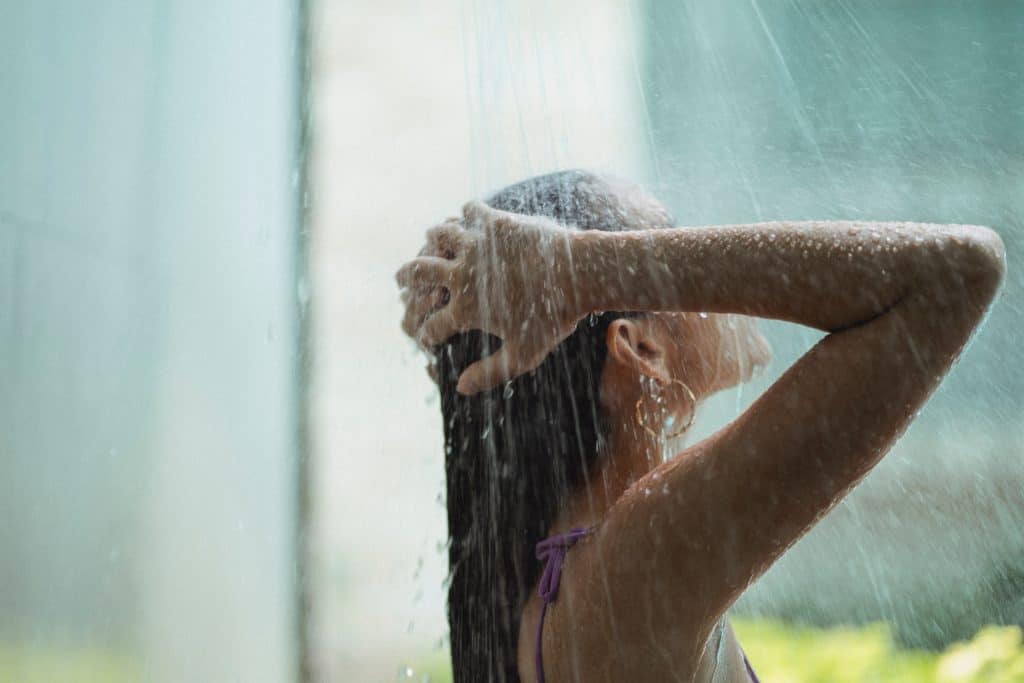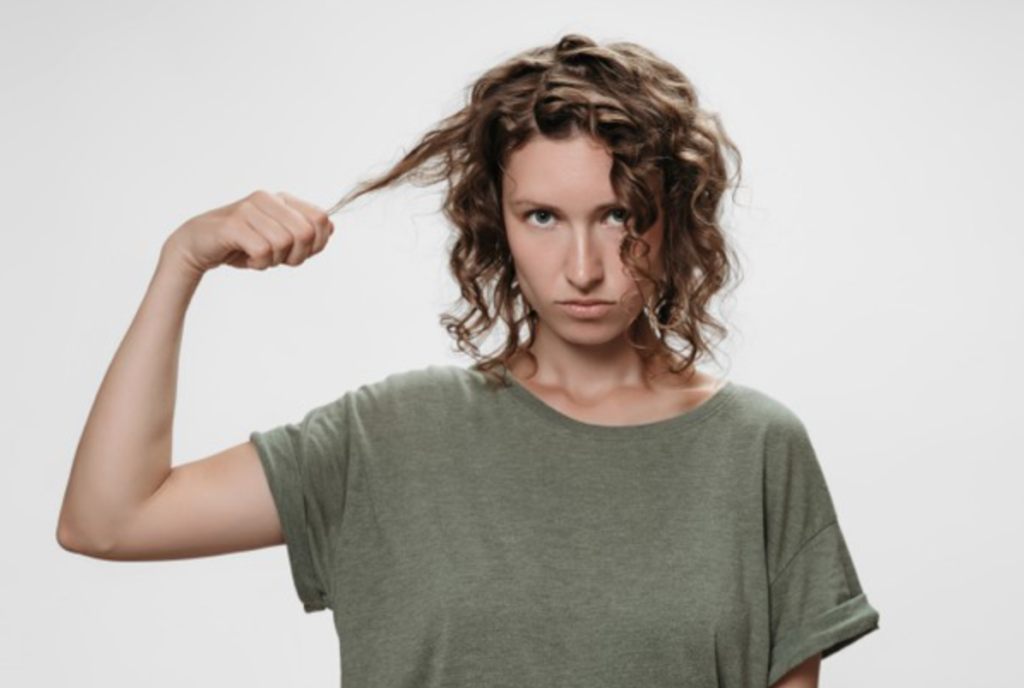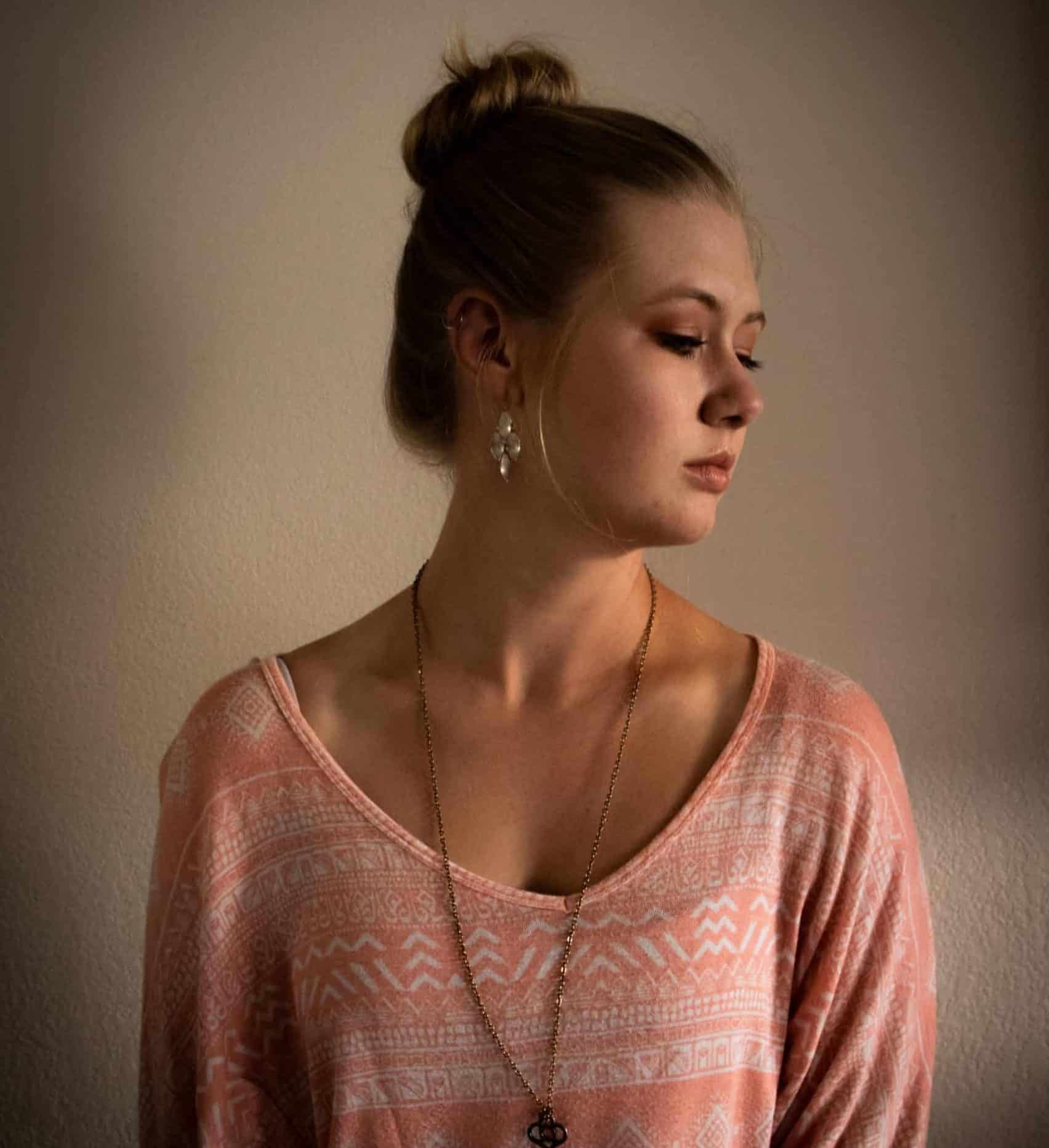Is it Okay to Wash Your Hair Once a Week?
The Exquisite Find contains affiliate links and is a member of Amazon Services LLC Associates Program, as well as the Sally Beauty Affiliate Program. If you make a purchase using one of the links listed in our posts, we may receive compensation at no extra cost to you. We only recommend products and services we use and trust. Please read our disclaimer for more information.
Is it okay to wash hair once a week? How often should you wash your hair?
Google says that you should only wash your hair every 2-3 days. Well, this is only partially true.
Each individual’s personal chemistry is different. For some once a week is enough, for others, it’s not enough. But why?

Is it Okay to Wash your Hair Once a Week?
What are the benefits of not washing your hair for a week?
One benefit of waiting to wash your hair is giving the scalp time to balance out the amount of oil it should produce without creating too much, or not enough.
Another reason to not wash your hair but maybe once a week is if you have artificial color in your hair. The bright fun colors, or a gorgeous toner for your highlights. Allowing several days, or a week even, between washes will allow the color to last longer and not rinse or fade out as quickly.
However, be aware that if your hair is dirty, you should wash it.
What happens when you wash your hair too often?
Too often is when you wash your hair when it’s not dirty. If there isn’t product in your hair, you haven’t been sweating, it’s still smooth and silky from the last wash, and your hair is still clean.
When the hair is washed too often the natural oils that your scalp makes and needs are stripped and your scalp becomes dry.
Everyday is too often. With the exception of having a job that leaves a lot of dirt or grime.
My professional advice is to wash your hair every 3-7 days. That is not too often, or too long.
18 Tips to Get Rid of Frizzy Hair Overnight
Too much oil and greasy scalp, means two things…
Either your scalp is naturally dry and is making excess oil as a cry for help because the pH is out of balance and has been for a while. Which is not terribly difficult to remedy. Or, it’s been a few days and the scalp is ready for a good wash.
Retraining the scalp to not make excess oil too fast and make the need to wash your hair almost daily is not difficult. But it does take determination and patience for this process. It may take up to 3 months to naturally retrain the scalp.
To do so means you must restore the pH of the scalp often enough and not strip all of the excess oil too often, or else this would communicate to the scalp that the excess that it’s making still isn’t rehydrating the scalp and it needs to make more. Therefore, stripping the excess oil too often will in fact make the scalp produce even more!
Why is greasy hair a cry for help? How do we go about preventing excess grease production and start training the scalp to restore it’s own pH without help? By being careful with what products you wash your hair with.
What happens when you don’t wash your hair often enough?
Not washing your hair often enough, like washing too often, can cause other issues that you don’t want. But is much less common than washing too much.
When you don’t wash your hair often enough, especially when you use products regularly like hairspray or pomade repeatedly in between washes, the products, oils, and dirt will build up on the hair and scalp.
There are several kinds of buildup.
Dirt, which looks dark splotches mixed with oil on the scalp.
Product buildup, including shampoo and conditioner with silicones and waxes will buildup on the hair and the scalp both.
Dirt and product buildup on the scalp if your hair isn’t washed often enough will seep into the pores and follicles of your scalp, causing blockage to hair growth and oil production both.
There’s a difference between washing your hair once a week and not often enough. Know where your hair sits in that balance.
Follicle and pore blockage 🙁
The blockage of the oil glands causes breakouts, pimples, blackheads and other irritations under the surface of the skin.
Blockage of the follicles, which is where the hair grows out of the skin, if the follicle has been blocked too long and the hair isn’t able to push through and grow out of the head it becomes in-grown or dies entirely.
When a follicle dies and the blockage hasn’t been removed, it will not grow again. However, the medicated cleanser line Nioxin is designed to encourage the best growth environment for the scalp. Sometimes it helps clear the blockage and the follicle will start growing hair again!
Wash your hair between 4-7 days. Any longer than that is not often enough.

How to Properly Wash your Hair
Some say only shampoo is enough. Others swear by shampoo and conditioner. Still, others say only conditioner! Which is it?!
Shampoo AND conditioner is the correct way to go. Not just one. And not just the other. But we’ll get to that in a moment.
The steps to properly wash your hair really only take a few minutes. Maybe 30 seconds would be too quick to properly get in a good scrub and allow the shampoo and conditioner to do their jobs, but it definitely shouldn’t take 15 minutes just to wash the hair.
Simple steps to washing your hair
First, you wet the hair, all the way to the scalp, not just the ends or what falls down your shoulders and back. Next, is to ONLY USE A QUARTER-SIZE AMOUNT OF SHAMPOO to start. If you need more than that, get more but don’t start with too much, that is just throwing expensive product down the drain.
After lathering the shampoo in your hands, scrub the scalp thoroughly. If you have crazy thick hair that tangles once wet, tilt your head so that you can get your fingers underneath the heavy locks and you can scrub the scalp well. It’s okay if you have to shampoo two times before the scalp feels and sounds clean (yes, squeaky clean is a real, listen for your hair’s squeak). Scrubbing in circular and up and down motions, massaging the shampoo into the scalp, thus using the hair itself to exfoliate the scalp and the hair, eliminating buildup.
Shampooing should primarily focus on the scalp, however, after the scalp has been thoroughly scrubbed, you may use some of the leftover lather from the scalp to gently rub into the length of your long hair.
Proceed to rinse. Is it squeaking?
Rinsing the hair consists of putting your entire head under the running water, allowing it to wash away all of the shampoo that has broken down the product buildup, grease and oil, and dirt clinging to the shampoo particles. This is the point when you should really be able to hear the squeak if you didn’t before. Now it’s time for the conditioner.
Repeat the steps of properly shampooing your hair except with the conditioner. START BY ONLY USING A QUARTER-SIZE AMOUNT OF CONDITIONER. Just like the shampoo, if you need more after that, use more. And continue applying to the scalp in the same way as listed above.
Don’t worry, we’ll talk about the myth of only conditioning the ends below. But first, we have to talk about proper products to use to wash your hair and which ones to avoid.
What do you wash your hair with? Does it matter?
Human hair and skin sit at a pH of 4.5-5.5, most generic shampoos have a pH of 10-11, which is far too alkaline, for the skin and hair. A shampoo with a pH of 7 is good, because it is enough to break down the oil and any product that is on the hair and scalp. However, you MUST use a conditioner after using shampoo (NOT 2 in 1 shampoo/conditioner) because a good conditioner has a pH of 4.5-5.5 and will restore the natural pH level so that the scalp doesn’t have to work twice as hard to rehydrate and restore the pH by itself.
2 in 1 shampoos and conditioners, or other multi-use soaps are not at all pH safe because if you mix a product with a pH of 7, and another with a pH of 4.5-5.5, the pH becomes neither helpful for breaking down the oils and products properly or restoring the pH to the natural level.
My personal and professional favorite is Original Sprout brand. It is a vegan product line designed by a stylist for those with allergies and severe skin sensitivities as well as truly pH-balanced! It’s an excellent line. Though, there are other brands that are also good for you to use.
What not to use? Behind the chair, the most damage I have seen a shampoo and conditioner do to hair has been from Suave and Pantene to be honest. But other generic brands tend to use a lot of filler ingredients including wax and silicone. Which builds up on both the hair and scalp, and makes the hair sticky when wet. To learn more about why silicone does more damage than good, please see The Exquisite Find’s article Silicone, why is it bad?
The myth of only conditioning the ends
But what about only conditioning the ends? Is that a thing?
Yes and no.
We’ve talked about what kind of products to avoid, and what kind of pH your products should have. Therefore, if the conditioner restores the pH of the scalp after you wash your hair with shampoo, why would you not restore the pH of the scalp?
Professionally, I do not recommend only conditioning the ends. The purpose of stylists ever suggesting conditioning only the ends and not the scalp is because the scalp is too oily already.
But like we already talked about, when the scalp is too oily it’s a cry for help for more hydration!
So, there. Don’t wash your hair and not condition the scalp. Be patient when retraining the scalp to make less oil, it’ll take a while.

What about leave-in conditioner?
If we don’t want buildup, and using conditioner post shampoo restores natural pH, what is leave-in conditioner for?
Leave-in conditioner is used to maintain the hydration of the hair after it’s dry. When hair is blow dried, or even air dried, the a good amount of the moisture is also taken out of the hair. So, a leave-in conditioner is used to keep the cuticle down and closed after it’s dry.
Leave-in conditioner is only used on the ends. Not on the scalp. If it needed on the scalp, it means that there isn’t enough oil production. There are other methods of restoring hydration to the scalp that are more efficient and better for the scalp.
Too much oil and greasy scalp, means two things…
Either your scalp is naturally dry and is making excess oil as a cry for help because the pH is out of balance and has been for a while. Which is not terribly difficult to remedy. Or, it’s been a few days and the scalp is ready for a good wash.
Retraining the scalp to not make excess oil too fast and make the need to wash your hair almost daily is not difficult. But it does take determination and patience for this process. It may take up to 3 months to naturally retrain the scalp.
To do so means you must restore the pH of the scalp often enough and not strip all of the excess oil too often, or else this would communicate to the scalp that the excess that it’s making still isn’t rehydrating the scalp and it needs to make more. Therefore, stripping the excess oil too often will in fact make the scalp produce even more!
Why is greasy hair a cry for help? How do we go about preventing excess grease production and start training the scalp to restore it’s own pH without help? By being careful with what products you wash your hair with.
The best hydrating mask
My favorite deep-conditioning mask to restore scalp hydration is a Flaxseed gel mask. It’s chemical-free and inexpensive to make. The flaxseed gel mask leaves minimal to no buildup, as well as a safe pH of 7.
When I use a flaxseed gel mask, I allow it to sit for 15 minutes and then rinse but use the Original Sprout conditioner (it has a pH of 5.5) to finish it off. And voila! A perfect pH balanced, nutritional and hydrating hair treatment after giving my hair a good wash.

Is it Okay to Only Wash Hair Once a Week? – FAQs
I have Fine Hair… how often should I wash it?
Fine hair does not mean thin. It simply means that your hair is smooth and very small when you feel a single strand between your fingers. How often you wash fine hair depends on your personal chemistry. There is no exact answer. If you feel like you need to wash more often, use the guidelines above to determine if you need to wash more often or not.
I have Coarse Hair… how often should I wash it?
Having coarse hair does not mean that it’s frizzy. Coarse hair does not mean curly hair either. It simply means that your hair is thicker than fine hair when you feel a single strand between your fingers. How often you wash course hair also on your personal chemistry. There is no exact answer. If you feel like you need to wash more often, use the guidelines above to determine if you need to wash more often or give it a few more days.
I have an Afro… how often should I wash it?
An afro is a specific type of style. Not necessarily a type of hair texture. An afro means curly hair that tends to grow, be cut, and worn in such a way that the curls surround the head in a gorgeous circular halo. Afros can be curly coarse hair, fine hair, or medium hair. And again how often you wash an afro depends on your personal chemistry. There is no exact answer. If you feel like you need to wash more often, use the guidelines above to determine if you need to wash more often or give it a few more days.
Does washing your hair once a week cause hair loss?
No. Washing your hair only once a week will not cause hair loss. Just like we discussed above, depending on your lifestyle, overall health, and personal chemistry should determine how often you should wash your hair. Once a week or more often.
The type of shampoo and conditioner will determine more so if hair loss occurs regularly if only washed once a week. If the product is high in silicones and waxes, the buildup and grease will be heavier and will cause more blockage in the scalp, which would cause hair loss over time.
Does washing your hair once a week make your hair grow faster?
No. The amount of times hair is washed during the week does not affect the speed that the hair grows. But what does?
Blood circulation. Which does occur more when the hair is washed, but also when the hair is brushed or the scalp is massaged. But the more often that you wash your hair does not grow hair faster.
How to Train Your Hair to Not Get Oily or Greasy
37 Easy Hairstyles for Dirty Hair
Camping Hairstyles Part II – Easy Tips and Tricks for Camping

